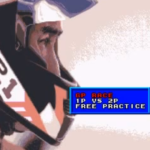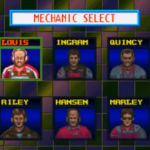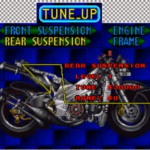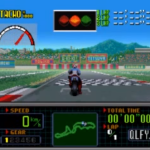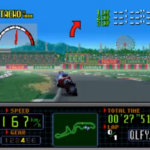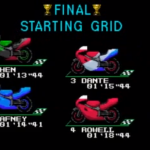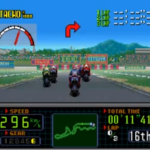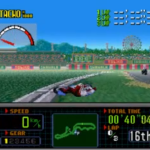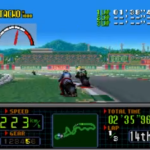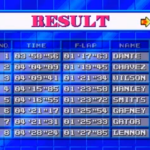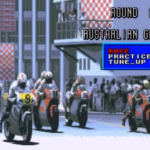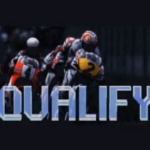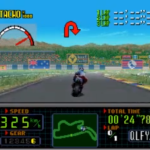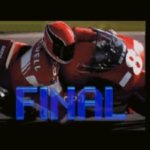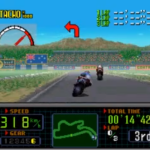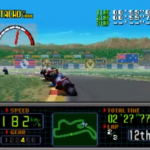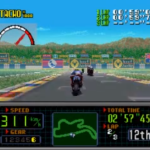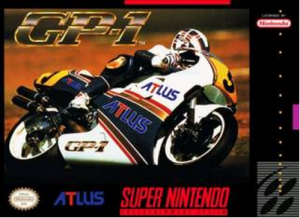
Author: John Legendoffzelda
There are higher stakes to racing on a motorcycle than some other modes of transportation. There’s less of an engineered safety barrier within the vehicle’s unsteady, open-faced design. And with the capability of reaching incredibly high speeds, the situation of injuring yourself by getting into an accident at 200 miles per hour carries a more direct corporeal consequence. With this layer of drama included, you ought to think the international sport of Grand Prix motorcycle racing would catch on in America the way that events like stock car racing do, but they strangely haven’t. It could be simple cultural dissonance, a case of audiences interested in seeing different machines being raced around a track; or maybe it’s also that media depictions of the sport haven’t done enough of a job of making it look engaging or fun. Atlus and Genki’s racing simulator GP-1, is certainly a case for this lackluster promotion. The game takes the player around the world through the Grand Prix, but for the whole duration of the trip, it makes the sport feel tedious and drab.
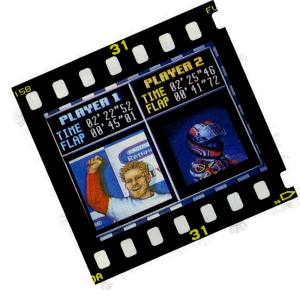 The main attraction in this game is the set of thirteen racetracks, set in countries ranging from Japan to South Africa to France and copied more or less from their real-life counterparts. Only enthusiasts will know for sure. As the driver, the player gets to take on these courses with one of six bikes at his disposal, and one of six coaches to help him spruce up his vehicle. All the stats for these motorbikes are presented in the opening screens and will likely be ignored as such, and it’s a sign of this game’s structure that this detail makes too much sense. On the racetrack, each vehicle feels virtually the same; or at least, whatever differences they have are nullified because all that matters is if they can navigate every winding turn that appears on screen. Even with a map and a series of arrows acting as heads-up indicators, the turns come quick and sharply, and if the player isn’t an expert at leaning, he’ll run off of the pavement or crash from wobbling too much. As for the coaches, they’re pointless as well – the player is the one buying the upgrades anyhow. The coaches aren’t even seen outside of their specific menu, just as much as those specifications about “suspension” and “engine” aren’t mentioned outside of the opening crawl, so it’s useless to pretend that they bear any meaning in the actual context. Both of these details end up as props that fail to occupy the game’s vacant atmosphere.
The main attraction in this game is the set of thirteen racetracks, set in countries ranging from Japan to South Africa to France and copied more or less from their real-life counterparts. Only enthusiasts will know for sure. As the driver, the player gets to take on these courses with one of six bikes at his disposal, and one of six coaches to help him spruce up his vehicle. All the stats for these motorbikes are presented in the opening screens and will likely be ignored as such, and it’s a sign of this game’s structure that this detail makes too much sense. On the racetrack, each vehicle feels virtually the same; or at least, whatever differences they have are nullified because all that matters is if they can navigate every winding turn that appears on screen. Even with a map and a series of arrows acting as heads-up indicators, the turns come quick and sharply, and if the player isn’t an expert at leaning, he’ll run off of the pavement or crash from wobbling too much. As for the coaches, they’re pointless as well – the player is the one buying the upgrades anyhow. The coaches aren’t even seen outside of their specific menu, just as much as those specifications about “suspension” and “engine” aren’t mentioned outside of the opening crawl, so it’s useless to pretend that they bear any meaning in the actual context. Both of these details end up as props that fail to occupy the game’s vacant atmosphere.
The player, with a motorcycle and a name that he has inputted into an outdated personal 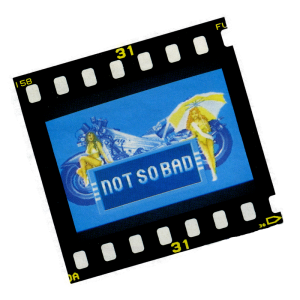 computer, must compete in all thirteen tracks as part of the Grand Prix mode. For each track players perform a qualifying lap first, then they race against fifteen other competitors to get first place. The higher they place at the end, the more money they earn for parts, which in all fairness probably affect the bike’s performance noticeably. But the player has to win against all the other racers first, and there’s no other way to address the embedded problem here: the A.I. rubberbands. No matter what, no matter how far ahead the player is, the competition will always be just outside of view; they travel in a pack, so that when the player inevitably runs into a patch of grass they’ll zoom towards the horizon and reduce you from first place to tenth. If the player catches up to the pack and attempts to muscle his way through, he can expect to clunk against a rival motorcycle and have his speed reduced, if he doesn’t outright crash instead. Worse yet, the player can at any given point have no idea where his rivals could be on the track. The camera for all courses is set at this ground-level view that only makes visible the immediate stretch of road ahead, with no view of any other side; hiding behind this curtain of a limitation the A.I. becomes free to exist anywhere, lazing around on the opposite side of the track and still able to teleport behind you at the moment you slip up so they can squash that sixteenth racer to last place.
computer, must compete in all thirteen tracks as part of the Grand Prix mode. For each track players perform a qualifying lap first, then they race against fifteen other competitors to get first place. The higher they place at the end, the more money they earn for parts, which in all fairness probably affect the bike’s performance noticeably. But the player has to win against all the other racers first, and there’s no other way to address the embedded problem here: the A.I. rubberbands. No matter what, no matter how far ahead the player is, the competition will always be just outside of view; they travel in a pack, so that when the player inevitably runs into a patch of grass they’ll zoom towards the horizon and reduce you from first place to tenth. If the player catches up to the pack and attempts to muscle his way through, he can expect to clunk against a rival motorcycle and have his speed reduced, if he doesn’t outright crash instead. Worse yet, the player can at any given point have no idea where his rivals could be on the track. The camera for all courses is set at this ground-level view that only makes visible the immediate stretch of road ahead, with no view of any other side; hiding behind this curtain of a limitation the A.I. becomes free to exist anywhere, lazing around on the opposite side of the track and still able to teleport behind you at the moment you slip up so they can squash that sixteenth racer to last place.
While egregious enough that the courses are full of nearly non-navigable turns and clotted with rivals hardwired to ruin your progress, it heaps a crushing amount of importance on winning each race. Every tenth-place-or-worse finish taunts the player of his shortcomings, with disappointed models holding up a message that says “Hopeless!” or “Try Again”, and it gives players the lowest cash reward possible. Whether or not those parts really do affect the bike’s performance, by the time the player can afford enough of them it’ll be too late in the Prix to improve on his standings – and that’s supposing he still doesn’t crash or lose hopelessly to the competitors. What do these upgrades do, anyway? Perhaps there are some specialists who know this information, but how would an improved frame or rear suspension make those turns any easier? It may just be that it’s ideal to buy every last thing, but in this game’s system of making money that would involve being a wizard. To even afford these upgrades, you have to perform the draining task of doing well enough that you likely didn’t need them in the first place.
Aside from its awful A.I. and controls, GP-1 still tries to reach for a rounded realism about 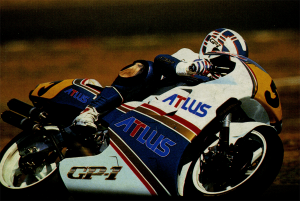 its subject matter. It has those finicky details about coaches and motorcycles with different frames, but that also means it makes the international locales look and sound like they would in person. The air is filled with the ambient buzzing of motors, and the ground is made of some Mode 7 terrain, but too many of the colors are damp and cool. For some of the tracks it looks like it finished raining. These artistic decisions don’t play well with the aforementioned camera, and honestly if it weren’t for the signs and sporadic absence of grass these courses would all be interchangeable. That’s really what GP-1 does to motorcycle racing: it makes the environments look flat and the skill of riding a motorcycle look dismal. No one who played this game would conceivably tune in to MotoGP on ESPN or whatever if they thought it looked like this.
its subject matter. It has those finicky details about coaches and motorcycles with different frames, but that also means it makes the international locales look and sound like they would in person. The air is filled with the ambient buzzing of motors, and the ground is made of some Mode 7 terrain, but too many of the colors are damp and cool. For some of the tracks it looks like it finished raining. These artistic decisions don’t play well with the aforementioned camera, and honestly if it weren’t for the signs and sporadic absence of grass these courses would all be interchangeable. That’s really what GP-1 does to motorcycle racing: it makes the environments look flat and the skill of riding a motorcycle look dismal. No one who played this game would conceivably tune in to MotoGP on ESPN or whatever if they thought it looked like this.
Two out of five stars.
COMMENT HERE
HAVE AN OPINION?
You can submit reviews for games on the Submissions page.







